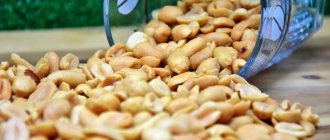Often, owners of four-legged animals humanize their pets too much, forgetting that in their desire to pamper the animal and express their feelings they can harm it. For example, not all owners ask the question “can dogs have sweets” and are happy to treat them with cookies, chocolate, candy or a piece of cake. If the owners do not do this, there are always friends and guests who are unable to resist the pleading gaze of the tailed cunning creatures and slowly feed them a tasty morsel, without thinking about the consequences. And they can be quite sad.
Is it possible to give a dog sugar?
First, you need to understand whether you can give your dog sugar, and what a sweet treat is for an animal. We usually classify sweets as sweets, cookies, marshmallows, marmalade, pies and cakes. But in fact, everything that contains refined sugar, even in small quantities, is sweet. Store-bought yoghurts, waffles, gingerbread cookies, crackers, white bread, buns, bagels and even honey can be classified in this category. Anything that contains fast carbohydrates in large quantities: pasta, sweet fruits (bananas, grapes in any form).
The animal’s body is completely unsuited to processing “artificial carbohydrates” and is unable to cope with them. After all, before dogs were domesticated by people, they didn’t eat sweets. In nature, it was quite difficult to obtain pure carbohydrates - bees do not just give up their product and sting painfully, and fruits grow high on trees. To the question “is it possible to give a dog sweets” there is only one answer - a categorical no!
Why sugar is bad for dogs
To answer the question of harm, you need to understand the anatomical features of your shaggy friends. Despite their changing diet, dogs are still carnivores. In the wild, they get everything they need from the meat and stomachs of their victims. The only sweets that are available to companions are vegetables and fruits. Sweets are the creation of human hands. They contain components exotic for animals.
Of course, palm oil, flavorings and dyes will not make your companion any better. However, the main problem is sugar. It is poorly absorbed by the dog's body. Some of the glucose immediately goes into use and provides the pet with energy. The overwhelming share is deposited in the liver (glycogen). This is a reserve stock that will be used up in a critical situation.
It is reasonable to assume that the reserves are retained in the dog's body for a long time. Pet sissies don't have to go hungry. On the contrary, they often receive extra treats that do not count toward the overall nutritional value. However, the liver's capabilities are limited. On average, the human liver can store approximately 300 g of glycogen. For a dog this figure is much less. What happens next?
Metabolic products literally poison your pet. There are so many toxins that the immune system reacts to them. An allergy begins: the eyes run, redness and itching appear. The skin on the ears and paws is most often affected. The dog scratches itself to the point of wounds and can chew out its fur. Usually all you need to do is review the menu. After this, the allergy will gradually go away ( how allergies manifest themselves in dogs: types, symptoms, diagnosis and treatment - read more in our article).
Why is sugar so bad?
Many people know that carbohydrates are an important and necessary element for the body. It is carbohydrates that are converted into energy. That is, they are really needed of high quality and in reasonable quantities. What happens if they enter the body in excess?
Substances obtained with food undergo a process of processing from carbohydrates into glucose, then into glycogen. In the form of glycogen, carbohydrates are contained in small quantities in the liver, blood and muscles. Any physical activity allows you to spend them, and at the next meal you can restore the supply. If the amount of carbohydrates entering the body exceeds its energy needs, there is only one way out - to put them “in reserve,” that is, in the form of fat deposits. As a result - metabolic disorders, diseases of the endocrine system, and sudden weight gain. Obesity in dogs is a fairly common problem.
Another problem is the risk of developing allergic reactions and general intoxication of the body. When the liver and pancreas cannot cope with large amounts of carbohydrates, metabolic products appear. They can cause allergies and become toxins. Dogs with a predisposition to diabetes are at risk. Even if you give your dog small portions of sweets, the disease will not be long in coming.
Is it possible to give sweets to dogs if there is no cause for concern and no obvious symptoms of any disease? The insidiousness of sugar is that health problems do not begin immediately. The negative effects of sweets are cumulative, and their manifestation is often associated with other diseases or the presence of parasites in the body. It can easily be mistaken for flea dermatitis, fungal infections or a tick bite.
You may be wondering what cereals can be given to dogs.
Healthy treats for four-legged animals
Sweets are important for dogs because without them it is difficult to achieve the recommended level of carbohydrates. Thanks to their pleasant taste, they are also good for rewards. To avoid the problems listed above, treats should be healthy and safe. These products include:
- Vegetables (pumpkin, beets, carrots, sweet potatoes). Improves intestinal function and prevents constipation. The recommended amount is 20-50 g per day.
- Unripe bananas. Rich in magnesium, potassium and selenium. Normalize hemoglobin levels and reduce the amount of “bad” cholesterol.
- Unsweetened apples, peeled and cored. They improve digestion and skin condition, and also have a beneficial effect on brain function.
- Honey. It is important to take the most common one, without additives. The norm per day for an adult medium-sized dog is 1 teaspoon, and for a puppy – 0.5 teaspoon. Honey often causes allergies, so be sure to monitor your body's reaction.
- Raspberries, strawberries and blueberries. Important for immunity and slow down the aging process. Despite the obvious benefits, berries should be given in moderation so as not to provoke allergies or diarrhea.
- Watermelons and melons. They are low in calories and rich in vitamin content. Due to their water content, these products put a lot of stress on the kidneys, so remember to use moderation, as in the case of berries.
In addition to natural sweets, it is recommended to use some industrial treats: dog biscuits, meat spirals, pig ears and sugar bones. They can be found at any pet store.
NOTE!
Fruits and berries with seeds, avocados, citrus fruits, grapes and raisins are strictly prohibited. Their use is fraught with suffocation, indigestion and intoxication.
Symptoms of poisoning
Manifestations of a negative reaction to sweets in a dog can be observed as:
- Sour eyes in the morning and throughout the day;
- Increased secretion of earwax, unpleasant odor from the ears, redness and dryness of the skin of the auricle;
- The animal's fur becomes faded, becomes oily, and dandruff may appear;
- Rash, redness, small sores, especially noticeable on the stomach, chest and chin;
Monitor the dog's condition. Other diseases with similar symptoms cannot be excluded. But, when talking with a veterinarian, you must tell them that the dog ate sweets. This will save time on making the correct diagnosis and allow you to prescribe effective treatment as quickly as possible.
What to do if your dog finds and eats chocolate or candy with candy wrappers
The danger is that pets do not know how to control themselves. If a person limits himself to a couple of sweets, then a dog can easily empty an entire vase. What should I do?
- If your companion swallows several soft caramels, nothing bad will happen to him. The worst thing that threatens him is allergies. Gradually it will go away on its own. Sometimes complications arise, but they are treated separately.
- If your dog has eaten an entire chocolate bar, you will have to go to the vet. The doctor will stabilize the pet's condition and assess the damage. First of all, the liver suffers from sweets. If everything is okay with her, the dog will quickly get back on his paws.
- Stuck candy wrappers are no less insidious. If the wrappers do not come out naturally, the dog may have to undergo surgery. Individual stuck candy wrappers are not always detected during examination, so sometimes this becomes a serious problem.
Candy, in large quantities, is harmful even to humans. And you definitely shouldn’t give them to dogs. This threatens a host of diseases: from intestinal blockage to pancreatitis. If you want to pamper your companion, it is better to give him a more suitable treat.
Why does a dog ask for sweets?
Owners often justify themselves by saying: “it’s impossible to refuse him, that’s the way he looks.” But the fault lies entirely with the owners. After all, it was you who encouraged the execution of the command with a piece of cookie, treated him with rich sweet cream from the cake, gave him candy so that the pet would leave the table. Each time, the dog developed abnormal eating behavior and a persistent attachment to sweets.
And every time you justified yourself that one piece would do nothing for your pet, or that occasionally you could still give your dog something sweet.
The dog is again plaintively begging for a piece of sweets: should he allow it?
Category: Education, Nutrition, Dog care
Is it possible to give a dog sweets? By the way, not all dog owners ask themselves this question. And completely in vain. It’s worth thinking about whether you can give your dog sweets and why. Let's look into this sugar issue.
My whole family loves sweets very much. And when we want to express love for our dog, our hand reaches out to some sweetness to treat our furry pet. But this is absolutely forbidden.
I recently looked at a survey of dog owners about who gives sweets to their pets. About one and a half thousand people took part in the survey. It turned out that about 50 percent of respondents sometimes give sweets to their dogs. Approximately 42% of people understand that sweets are harmful for dogs and do not give them. And 7.8 percent of people give sweets to dogs on a regular basis!!! Moreover, they do not consider it something harmful.
Dogs are carnivores. And they, unlike herbivores, have completely different metabolic processes in the body. The dog's body does not absorb glucose. Therefore, the consequence of eating sweets can be, in some cases, poisoning and intestinal problems, and with systematic consumption - allergies, dental problems, purulent eyes and liver diseases. In some cases, diabetes mellitus may occur. The effect on large dogs is not as strong as on small ones. Therefore, owners of miniature dogs need to be more careful. You should not think that because you sometimes give your dog sweets and nothing happens, then you can continue to do so. Sweets have a cumulative effect on the dog’s body and the liver will experience serious stress.
I would also like to talk about chocolate. Chocolate contains an element called theobromine. Its effect is as follows: the dog’s blood vessels narrow, the pulse quickens, the heart’s function is disrupted, and the load on the kidneys increases. There is a sharp stimulation of the central nervous system. When eating chocolate, the dog may begin to sneeze, convulsions, vomiting, and diarrhea. Heart failure may occur. Well, the saddest consequence can be death. Here again, small dogs are at greater risk.
Theobromine is poisonous not only to dogs, it also has a detrimental effect on the bodies of cats, horses, and birds.
You can replace sweets with natural products that your pet will eat with pleasure. This includes fruits and dried fruits. Raspberries, bananas, blueberries and apples are best. It is better not to give grapes and raisins, they are toxic to dogs. If your dog is prone to obesity, then you need to be careful when giving dried fruits in large quantities, as they are quite high in calories. Instead of ready-made sweets, you can give your dog natural honey, but not more than one teaspoon per day. Also very useful for the dog will be seeds and nuts, which he will eat with great pleasure. Well, you can also please your pet with vegetables. It could be raw carrots or potatoes.
You should not think that by giving sweets to your dog, we once again confirm our love for it. It’s better to walk outside with your pet for another hour more. Express your love by paying attention to her. A dog does not need a varied menu, much less sweets. And you can treat your furry friend with the natural products listed above.
If you do not agree whether a dog can have sweets , then write to us and we will discuss it.
Post Views: 51
Liked this:
Like Tags: raising a dog, dogs, caring for a dog
How to replace sweets
Can dogs be given sweets in any other form? Is there an alternative to sugar, how to make your pet’s diet correct and balanced, but at the same time be able to pamper him with something tasty?
Manufacturers of food and pet products are well aware of the problem and the challenge facing them. The industry offers a huge range of treats for dogs that can replace harmful sweets and develop new, good and correct eating habits:
- Biscuits with the flavors of your favorite delicacies (chocolate, yogurt) will replace sweet pies and cakes. Suitable as a treat after unloved procedures (brushing teeth, ears, trimming nails, etc.);
- Croquettes, cookies - suitable as rewards during walks and activities;
- By-products, dried ears, sinews, tripe, tails are given to the dog to distract them from the table while people are eating. In addition, such treats help maintain healthy teeth.
Chocolate and its effect on the dog's body
Chocolate and chocolate products can cause poisoning and even death of an animal. It contains theobromine, an alkaloid found in cocoa beans. This is poison for dogs. It is excreted slowly and remains in the bloodstream for up to 20 hours, disrupting the functions of the heart, blood vessels, kidneys, and nervous system. Most of all it is found in dark dark chocolate.
Regular feeding of chocolate products, but in small quantities, worsens the condition of the coat, skin, eyes, kidneys, and impairs blood circulation. This product causes kidney failure, pancreatitis, epilepsy, and pancreatic diseases. The lethal portion of chocolate is 200 mg per 1 kg of dog weight. However, she can be poisoned at a dose of 15-80 mg per 1 kg of body weight. The less the pet weighs, the less sweets are needed for it to become poisoned.
Another reason why you should not treat your animal to chocolate is because it contains sugar, dyes, stabilizers, flavors and other chemical fillers.
Strictly prohibited
There are sweets that are especially harmful to dogs - for example, ice cream. It is a combination of milk, fats and sugar. This is a huge burden for a pet’s body, especially a small breed. At best, the animal will suffer from indigestion, diarrhea and the difficulties described above.
Flour confectionery products - white flour and sugar are a very harmful combination not only for dogs, but also for people. Their use should not be limited, but completely excluded from the animal’s diet. Grapes and raisins are record holders for sugar content. It is strongly not recommended to give them to your dog.
It is strictly forbidden to give your dog chocolate. This seemingly simple treat can become deadly for your pet. You can read more about this in the article “Can a dog have chocolate?”
Harmful sweets
All food containing sugar, sweeteners and dyes is harmful to your pet's health. But there are confectionery products, the consumption of which poses a mortal danger.
Chocolate in any form is a prohibited product.
Chocolate is made from cocoa beans. They contain theobromine, which is quickly processed by the digestive enzymes of the human body. The dog's liver does not produce enzymes for the absorption of theobromine , so the cocoa bean component accumulates in organ tissues. Reaching a high concentration, this substance has a destructive effect on the nervous and cardiovascular system of the pet. Behavioral disorder, arrhythmia and loss of consciousness are observed until the onset of coma.
Lethal doses of the product:
- 400 g of dark chocolate with 70% cocoa beans will kill a dog weighing 15-20 kg within an hour.
- 2.8 kg of milk chocolate is a lethal dose for an animal weighing 15-20 kg.
White chocolate does not contain theobromine, but this treat is also contraindicated.
Other health hazards include:
- pastries and cream pies;
- butter cookies, pies and buns;
- any candy.
These products are never included in your pet's menu.
Harmful and healthy sweets for pets
The pet owner must know which sweets are strictly prohibited for his pet. But at the same time, keep in mind how you can pamper your pet and what sweet, tasty treats you can treat him to.
Harmful sweets
In addition to sugar itself, there is a whole list of various treats that should never be given to a dog. The list of prohibited products includes the following:
- chocolate, chocolate candies, etc. (as mentioned earlier, it contains a substance harmful to four-legged pets - theobromine. Find out in detail whether dogs can have chocolate.);
- xylitol (it was also discussed earlier: it is a sweetener that is found in almost all confectionery products);
- raisins and fresh grapes (for predators this fruit is toxic and, among other things, gives rise to a fermentation process in the intestinal tract);
- sweet acorn (it contains the toxic substance gallotannin, which is used in pharmaceuticals);
- citrus fruits (usually four-legged pets themselves refuse this product, but there are also exceptions; it is important to keep in mind that fruits belonging to this category cause a severe allergic reaction in dogs);
- persimmons, cherries, sweet cherries and other fruits with large seeds inside (once in the small intestine, these seeds provoke obstruction and internal inflammation);
- avocado (this exotic fruit contains persin, a substance that has a toxic effect on the body of domestic animals, including dogs; in the latter it causes stomach upset).
Healthy sweets for dogs
So is it still possible to give sweets to dogs? Despite the fact that products containing sugar are harmful to four-legged pets, some of them are still allowed for consumption. What vegetables and fruits can be given to dogs and what are their benefits? This list includes the following products:
- vegetables, in particular, such as: carrots, pumpkin, sweet potatoes, rutabaga, parsnips, beets (keep in mind that the latter has a laxative effect);
- bananas, this fruit is very good for health because it contains vitamins B and C, as well as potassium (consuming bananas in large quantities can cause constipation);
- apples contain useful elements, and due to their hardness and fibrous structure, they have a beneficial effect on the condition of teeth (before treating your dog with an apple, do not forget to remove the seeds from the fruit, cutting out the middle - the fact is that the core of apples contains cyanide in small doses, however, this may be enough to harm the animal);
- watermelons, melons, dogs really like melons, but it is better to give them in small portions and infrequently, because watermelon puts a lot of strain on the excretory system, including the kidneys, and melon is difficult to digest;
- honey - this product is rich in nutrients and vitamins; You can treat your dog with a treat, provided that the product does not cause allergies in the animal;
- nuts (pine, almonds), sesame, sunflower seeds, sprouted wheat seeds (oats); the latter is a rather sweet product and contains many useful elements; and yet you should not abuse such food, since sprouted grains can cause diarrhea in a dog; Also, do not forget that it is strictly forbidden to feed your pet a sweet acorn (despite the fact that it is a nut, it, as you remember, contains a dangerous substance - gallotannin).
Thus, we found out that dogs are prohibited from eating sweets, for what reason owners should limit their pets’ treats, and also what sweet foods are still allowed to be consumed. It is very important that owners monitor their pets’ diet as closely as possible and in no case allow sugar-containing products in it, and also control the amount of sweets, which are allowed to be consumed occasionally and in small portions.











